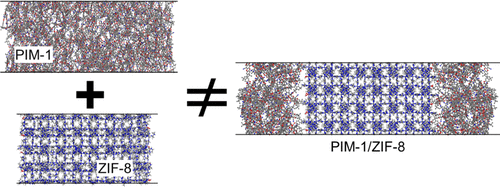当前位置:
X-MOL 学术
›
Chem. Mater.
›
论文详情
Our official English website, www.x-mol.net, welcomes your feedback! (Note: you will need to create a separate account there.)
Modeling of Gas Transport through Polymer/MOF Interfaces: A Microsecond-Scale Concentration Gradient-Driven Molecular Dynamics Study.
Chemistry of Materials ( IF 8.6 ) Pub Date : 2020-01-07 , DOI: 10.1021/acs.chemmater.9b04907 Aydin Ozcan 1 , Rocio Semino 2 , Guillaume Maurin 2 , A Ozgur Yazaydin 1
Chemistry of Materials ( IF 8.6 ) Pub Date : 2020-01-07 , DOI: 10.1021/acs.chemmater.9b04907 Aydin Ozcan 1 , Rocio Semino 2 , Guillaume Maurin 2 , A Ozgur Yazaydin 1
Affiliation

|
Membrane-based separation technologies offer a cost-effective alternative to many energy-intensive gas separation processes, such as distillation. Mixed matrix membranes (MMMs) composed of polymers and metal-organic frameworks (MOFs) have attracted a great deal of attention for being promising systems to manufacture durable and highly selective membranes with high gas fluxes and high selectivities. Therefore, understanding gas transport through these MMMs is of significant importance. There has been longstanding speculation that the gas diffusion behavior at the interface formed between the polymer matrix and MOF particles would strongly affect the global performance of the MMMs due to the potential presence of nonselective voids or other defects. To shed more light on this paradigm, we have performed microsecond long concentration gradient-driven molecular dynamics (CGD-MD) simulations that deliver an unprecedented microscopic picture of the transport of H2 and CH4 as single components and as a mixture in all regions of the PIM-1/ZIF-8 membrane, including the polymer/MOF interface. The fluxes of the permeating gases are computed and the impact of the polymer/MOF interface on the H2/CH4 permselectivity of the composite membrane is clearly revealed. Specifically, we show that the poor compatibility between PIM-1 and ZIF-8, which manifests itself by the presence of nonselective void spaces at their interface, results in a decrease of the H2/CH4 permselectivity for the corresponding composite membrane as compared to the performances simulated for PIM-1 and ZIF-8 individually. We demonstrate that CGD-MD simulations based on an accurate atomistic description of the polymer/MOF composite is a powerful tool for characterization and understanding of gas transport and separation mechanisms in MMMs.
中文翻译:

通过聚合物/ MOF界面进行气体传输建模:微秒级浓度梯度驱动的分子动力学研究。
基于膜的分离技术为许多能源密集型气体分离工艺(例如蒸馏)提供了一种经济高效的替代方法。由聚合物和金属有机骨架(MOF)组成的混合基质膜(MMM)作为制造具有高气体通量和高选择性的耐用且高选择性膜的有前途的系统,已经引起了广泛的关注。因此,了解通过这些MMM的气体传输非常重要。长期以来一直推测,由于潜在存在非选择性空隙或其他缺陷,在聚合物基体与MOF颗粒之间形成的界面处的气体扩散行为将极大地影响MMM的整体性能。为了进一步阐明这种范例,我们已经进行了微秒长浓度梯度驱动的分子动力学(CGD-MD)模拟,以前所未有的方式观察了PIM-1 / ZIF-8膜中H2和CH4作为单一组分和混合物的传输形式,包括聚合物/ MOF界面。计算了渗透气体的通量,清楚地揭示了聚合物/ MOF界面对复合膜的H2 / CH4渗透性的影响。具体而言,我们表明PIM-1和ZIF-8之间的相容性差,这通过其界面处存在非选择性空隙空间而表现出来,与相应的复合膜相比,H2 / CH4的选择性渗透性降低了。分别针对PIM-1和ZIF-8模拟的性能。
更新日期:2020-01-21
中文翻译:

通过聚合物/ MOF界面进行气体传输建模:微秒级浓度梯度驱动的分子动力学研究。
基于膜的分离技术为许多能源密集型气体分离工艺(例如蒸馏)提供了一种经济高效的替代方法。由聚合物和金属有机骨架(MOF)组成的混合基质膜(MMM)作为制造具有高气体通量和高选择性的耐用且高选择性膜的有前途的系统,已经引起了广泛的关注。因此,了解通过这些MMM的气体传输非常重要。长期以来一直推测,由于潜在存在非选择性空隙或其他缺陷,在聚合物基体与MOF颗粒之间形成的界面处的气体扩散行为将极大地影响MMM的整体性能。为了进一步阐明这种范例,我们已经进行了微秒长浓度梯度驱动的分子动力学(CGD-MD)模拟,以前所未有的方式观察了PIM-1 / ZIF-8膜中H2和CH4作为单一组分和混合物的传输形式,包括聚合物/ MOF界面。计算了渗透气体的通量,清楚地揭示了聚合物/ MOF界面对复合膜的H2 / CH4渗透性的影响。具体而言,我们表明PIM-1和ZIF-8之间的相容性差,这通过其界面处存在非选择性空隙空间而表现出来,与相应的复合膜相比,H2 / CH4的选择性渗透性降低了。分别针对PIM-1和ZIF-8模拟的性能。



























 京公网安备 11010802027423号
京公网安备 11010802027423号